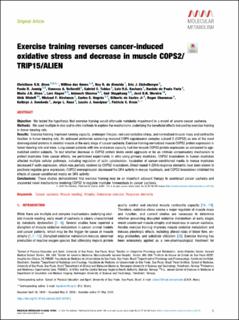| dc.contributor.author | Alves, Christiano R. R. | |
| dc.contributor.author | des Neves, Willian | |
| dc.contributor.author | de Almeida, Ney R | |
| dc.contributor.author | Eichelberger, Eric J | |
| dc.contributor.author | Jannig, Paulo R. | |
| dc.contributor.author | Voltarelli, Vanessa A | |
| dc.contributor.author | Tobias, Gabriel C | |
| dc.contributor.author | Bechara, Luiz R G | |
| dc.contributor.author | de Paula Faria, Daniele | |
| dc.contributor.author | Alves, Maria J N | |
| dc.contributor.author | Hagen, Lars | |
| dc.contributor.author | Sharma, Animesh | |
| dc.contributor.author | Slupphaug, Geir | |
| dc.contributor.author | Moreira, Jose Bianco Nascimento | |
| dc.contributor.author | Wisløff, Ulrik | |
| dc.contributor.author | Hirshman, Michael F. | |
| dc.contributor.author | Negrao, Carlos E. | |
| dc.contributor.author | de Castro Jr, Gilberto | |
| dc.contributor.author | Chammas, Roger | |
| dc.contributor.author | Swoboda, Kathryn J. | |
| dc.contributor.author | Ruas, Jorge L. | |
| dc.contributor.author | Goodyear, Laurie J. | |
| dc.contributor.author | Brum, Patricia Chakur | |
| dc.date.accessioned | 2022-11-18T09:48:51Z | |
| dc.date.available | 2022-11-18T09:48:51Z | |
| dc.date.created | 2021-01-11T11:08:18Z | |
| dc.date.issued | 2020 | |
| dc.identifier.issn | 2212-8778 | |
| dc.identifier.uri | https://hdl.handle.net/11250/3032790 | |
| dc.description.abstract | Objective
We tested the hypothesis that exercise training would attenuate metabolic impairment in a model of severe cancer cachexia.
Methods
We used multiple in vivo and in vitro methods to explore the mechanisms underlying the beneficial effects induced by exercise training in tumor-bearing rats.
Results
Exercise training improved running capacity, prolonged lifespan, reduced oxidative stress, and normalized muscle mass and contractile function in tumor-bearing rats. An unbiased proteomic screening revealed COP9 signalosome complex subunit 2 (COPS2) as one of the most downregulated proteins in skeletal muscle at the early stage of cancer cachexia. Exercise training normalized muscle COPS2 protein expression in tumor-bearing rats and mice. Lung cancer patients with low endurance capacity had low muscle COPS2 protein expression as compared to age-matched control subjects. To test whether decrease in COPS2 protein levels could aggravate or be an intrinsic compensatory mechanism to protect myotubes from cancer effects, we performed experiments in vitro using primary myotubes. COPS2 knockdown in human myotubes affected multiple cellular pathways, including regulation of actin cytoskeleton. Incubation of cancer-conditioned media in mouse myotubes decreased F-actin expression, which was partially restored by COPS2 knockdown. Direct repeat 4 (DR4) response elements have been shown to positively regulate gene expression. COPS2 overexpression decreased the DR4 activity in mouse myoblasts, and COPS2 knockdown inhibited the effects of cancer-conditioned media on DR4 activity.
Conclusions
These studies demonstrated that exercise training may be an important adjuvant therapy to counteract cancer cachexia and uncovered novel mechanisms involving COPS2 to regulate myotube homeostasis in cancer cachexia. | en_US |
| dc.language.iso | eng | en_US |
| dc.publisher | Elsevier | en_US |
| dc.rights | Attribution-NonCommercial-NoDerivatives 4.0 Internasjonal | * |
| dc.rights.uri | http://creativecommons.org/licenses/by-nc-nd/4.0/deed.no | * |
| dc.title | Exercise training reverses cancer-induced oxidative stress and decrease in muscle COPS2/TRIP15/ALIEN | en_US |
| dc.title.alternative | Exercise training reverses cancer-induced oxidative stress and decrease in muscle COPS2/TRIP15/ALIEN | en_US |
| dc.type | Peer reviewed | en_US |
| dc.type | Journal article | en_US |
| dc.description.version | publishedVersion | en_US |
| dc.source.journal | Molecular Metabolism | en_US |
| dc.identifier.doi | 10.1016/j.molmet.2020.101012 | |
| dc.identifier.cristin | 1868737 | |
| cristin.ispublished | true | |
| cristin.fulltext | original | |
| cristin.qualitycode | 1 | |

